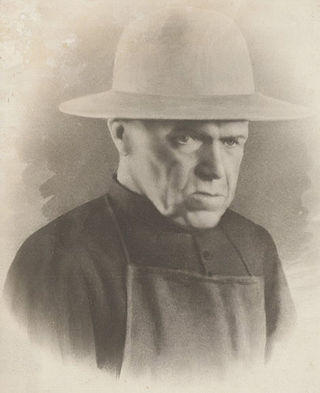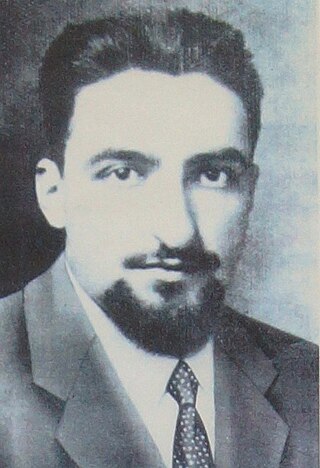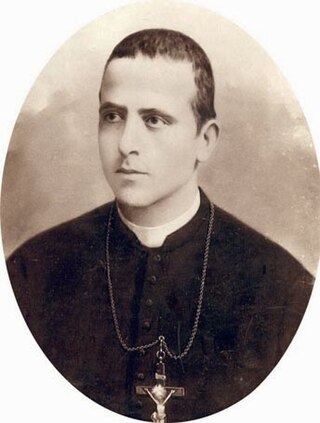Related Research Articles
Arcangelo Tadini was an Italian Roman Catholic priest. Tadini was ordained as a priest in 1870 and went on to found a religious congregation dedicated to the poor and ill while taking advantage of the Industrial Revolution to support women in work and education. Tadini was disabled due to a lame leg he had after suffering an accident while he studied for the priesthood. He initiated various parish initiatives and a relief fund for the aged and the ill.
Paolo Manna was an Italian Roman Catholic priest and a member from the Pontifical Institute for Foreign Missions as well as the founder of the Pontifical Missionary Union. Manna worked in the missions in Burma and even served as the Superior General for PIME. Manna did much in his life to promote the missions and the evangelic and apostolic zeal that accompanied it and he established newspapers and movements to help promote this charismatic apostolate. He also held several leadership positions in PIME and used that standing in order to further engage with prospective missionaries.

Stanisław Kazimierczyk was a Polish Catholic priest and a professed member of the Canons Regular of the Lateran. He became noted for his ardent devotions to both the Eucharist and to his personal patron saint, Stanislaus of Szczepanów, as well as for his charitable dedication to the ill and poor of Kraków.
Giuseppe Ambrosoli was an Italian Catholic priest and professed member from the Comboni Missionaries of the Heart of Jesus. He served as a doctor and surgeon as well as being a philanthropist and educator in the missions in Uganda. Ambrosoli studied before World War II when he once risked his life to smuggle Jewish people into Switzerland before returning home to finish his studies in medicine prior to commencing his ecclesial studies. He joined the Comboni missionaries and was sent to Uganda where he became known as the "saint doctor" for his loving and compassionate treatment of all ill people whom he dedicated himself to.
Luigi Talamoni was an Italian Roman Catholic priest and the founder of the Merciful Sisters of Saint Gerard. Talamoni also held civic office for a brief period though later resigned due to the rise of Fascism in the area and dedicated his career to proper care for the poor and to the maintenance of civic infrastructure. His beatification was celebrated in 2004.
Giuseppina Nicoli was an Italian Roman Catholic religious sister. Nicoli - aged 20 at the time - became a member of the Vincentians and became a catechist in Sardinia where she was positioned for most of her life despite holding several positions of leadership in Turin and elsewhere for a brief period.

Louis Brisson, OSFS was a French Roman Catholic priest and the founder of both the Oblate Sisters of St. Francis de Sales and the Oblates of St. Francis de Sales. He founded the female branch alongside Léonie Aviat and the male branch alongside the Servant of God Thérèse Chappuis. Brisson's founding of the congregations stemmed from his desire to improve the working conditions of middle-class girls and to ensure their protection and the promotion of their faith.

Jan Beyzym, SJ was a Polish Catholic priest and a professed member of the Jesuits. He served as an educator in Jesuit boarding schools for a while after his ordination though later left Poland to work alongside lepers in Madagascar where he remained until his death.

Rudolf Komórek was a Polish priest and a professed member of the Salesians of Don Bosco while also serving as part of the missions in Brazil. He served during World War I as a hospital chaplain and began the process of joining the order of Saint John Bosco following his time as a prisoner of war in Trento.

Assunta Marchetti was an Italian Roman Catholic religious sister and the co-founder of the Missionary Sisters of Saint Charles Borromeo Scalabrinians; she worked in Brazil from 1895 until her death. She has been beatified as a Blessed Mother. Her priest brother Giuseppe is titled as Venerable on the path to sainthood.
Luca Passi was an Italian priest and the founder of the Teaching Sisters of Saint Dorothy. Two brothers of his were priests – following the example of their paternal uncle – and Passi himself moved to Venice in order to dedicate himself to both his preaching and educational missions.
Secondo Pollo was an Italian Roman Catholic priest and a chaplain who served in World War II. He died during a skirmish in 1941 in which a bullet struck him while he attended to a wounded comrade.

Blessed Luigi Monza was an Italian Roman Catholic priest and the founder of the Secular Institute of the Little Apostles of Charity. Monza's pastoral mission was defined with catering to the needs of the poor and the sick and used his new congregation as a means of spreading this mission.

Teresio Olivelli was an Italian Roman Catholic soldier during World War II and part of the Italian Resistance movement to Fascism and the Nazi regime. Olivelli graduated in law in Pavia in 1938 and went on to comment in papers on the legal and social issues of the time before he became a volunteer fighter for the Nationalist faction during the Spanish Civil War and in World War II with a notable campaign fought in Russia. The war soured his views towards the Italian fascist regime of Benito Mussolini and his time in the resistance was marked with articles in a newspaper he founded dedicated to promoting the Christian message and attempting to improve upon aspects of fascism with a more Christian message.

Arsenio da Trigolo, OFM Cap., was an Italian Catholic priest and a professed member from the Order of Friars Minor Capuchin.

Enrico Rebuschini was an Italian Roman Catholic priest and professed member from the Camillians. Rebuschini was marked since his childhood as one who had an innate desire to tend to the poor and marginalized and felt the need to hand out his possessions to those less fortunate than himself. But his father opposed his vocation to the priesthood and directed him to studies which he threw himself into in obedience to him. But he felt dissatisfied upon working with his brother-in-law in the silk business and made a final plea to his father to become a priest. His father relented and he commenced his ecclesial studies though in his life afterwards experienced several profound episodes of nervous depression that caused him to grow ill each time.

Jean-Baptiste Fouque was a French Roman Catholic priest. He tended to the poor during his time as a parish priest in Marseilles and was noted for his desire to create a large and free hospital for them. He achieved this in 1921 and tended to the old and infirm in the hospital. Fouque also was known for his ministering to displaced peoples during World War I and for his commitment to evangelization.

Nicola Mazza was an Italian Catholic priest known for his work in the African missions of the 19th century. He was dedicated to both the evangelization of Central Africa and equal access to a good education.

Giuseppe Marchetti was an Italian Roman Catholic priest from the Missionaries of Saint Charles Borromeo and the co-founder of the Sisters Missionaries of Saint Charles Borrome; and from the beatification process, titled as a Venerable. Marchetti served first as a local pastor after his ordination but decided to later help Giovanni Battista Scalabrini in his mission to tend to and support Italian emigrants. He started to take trips to Brazil to focus on Italians relocating there and later moved there to found an orphanage and to work alongside abandoned children and emigrants. He also invited his sister, Assunta Marchetti, to help him in his work and she would continue his mission for the four decades after his death. She herself would become beatified, as a Blessed Mother.
Mario Ciceri was an Italian Roman Catholic priest from Milan. He was born to farmers and had an inclination to enter the priesthood since his childhood; he studied in Bergamo and in Milan before he was ordained as a priest at the Duomo in 1924 and was assigned his first pastoral role at a local parish church. Ciceri became renowned for his diligent attention to the poor and to the sick and also focused on children and teenagers. He revitalized Catholic Action in his area and was responsible for having recruited teens into the movement.
References
- 1 2 3 "Blessed Serafino Morazzone". Santi e Beati. Retrieved 1 November 2016.
- 1 2 3 "Don Serafino Morazzone" (PDF). Chiesa di Milano. Retrieved 1 November 2016.
- ↑ Index ac status causarum beatificationis servorum dei et canonizationis beatorum (in Latin). Typis polyglottis vaticanis. January 1953. p. 207.